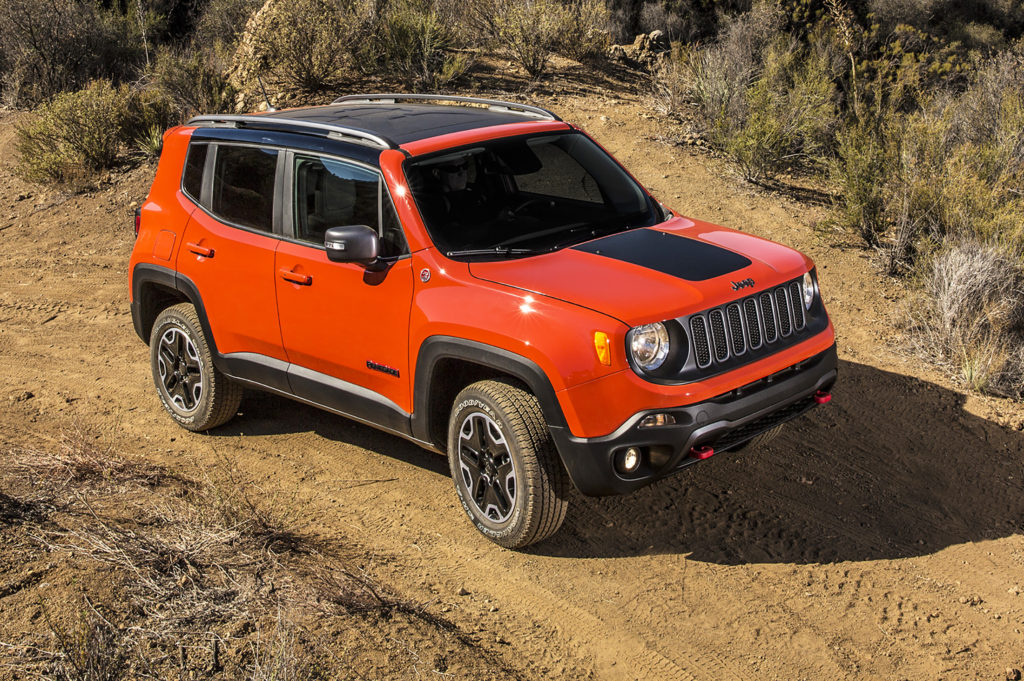Cargazing
By Derek Price
In the past, I’ve tested the Jeep Renegade Trailhawk on the rugged, steep, rocky trails it’s designed to traverse.
This time, my schedule happened to require a different kind of test: mile after mile of straight highways — not exactly the Trailhawk’s strong point.
After a lot of interstate driving, I discovered that the tradeoffs required from an off-road mini Jeep aren’t all that extreme. The built-for-wilderness version of the Renegade is a bit rougher riding and transmits a hint more road noise than its siblings that are tuned for street use, but it’s still very livable, even on long road trips.
It’s the kind of vehicle you can drive to work every day and take to your favorite off-road adventure park on the weekends.
The best part about the Renegade is that it paves the way for Jeep to expand its appeal without losing its soul.
Most Renegades are built for people who want the Jeep look and daring reputation but don’t necessarily need true Jeep performance. I’d guess the vast majority of Renegade buyers fall into this class — people who regularly take their Jeep into very light off-roading, if anything.
Jeep’s soul, though, lies somewhere out on the Rubicon Trail where few of us can go.

With a unique sense of style, the Renegade looks like the Jeep of the future. It’s a global design, built in Italy, but retains the brand’s all-American sense of off-road adventure.
Despite being very different from the classic idea of a Jeep — smaller, car-based, and built in Italy of all places — the Renegade wins back some purist points with its seriously designed, well-engineered Trailhawk version.
The Renegade Trailhawk comes standard with Jeep’s exclusive Active Drive Low with a 20-to-1 crawl ratio, the Selec-Terrain system that lets you easily configure it for different conditions including a rock-crawl mode, along with a number of hardware changes to beef it up.
It rides almost an inch higher than the regular Renegade and comes with skid plates, unique front and rear fascias to help it tackle steeper angles on trails, a suspension that allows more than 8 inches of wheel articulation, and tow hooks in front and back.
It’s looks the part, too.
Those tow hooks are painted red, for starters, a simple touch that I think is ridiculously cool. It’s like big red brake calipers on a Ferrari.
And the overall shape and styling on the Renegade is one of the most unique and innovative on the market. At a time when nearly all the small crossovers it competes against look pretty much the same — the automotive version of beige walls — it stands apart like a neon green sculpture. It’s stunningly, proudly different in a crossover market where everyone else just wants to blend in.
If I could change one thing about the Renegade it would be the base engine. The 2.4-liter Tigershark never feels as spunky as the vehicle looks, and I found myself wishing for more power on more than a few on-ramps.
On the bright side, its nine-speed automatic transmission feels impressively well sorted. Fiat Chrysler Automobiles struggled to make its nine-speeds feel refined when they were first introduced a few years ago, but it seems to get better with each passing year as they fine-tune the shift points and programming. On my Renegade tester, I hardly even noticed it shifting.

The Renegade’s cabin echoes its creative body design. It’s not only functional, with a well-thought-out design, but also packed with fun surprises and playful styling touches.
For 2017, Jeep is adding two new models to the Renegade lineup: Deserthawk and Altitude.
The Deserthawk comes with a high level of standard off-road equipment and unique styling inspired by arid climates, including painted black wheels, snazzy body decals and an exclusive color choice called Mojave Sand.
The Altitude matches the look of other Jeeps with this package, giving it an aggressive, blacked-out look. Lots of gloss black trim pieces, both inside and out, give it a sinister appearance.
At A Glance
What was tested?
2016 Jeep Renegade Trailhawk 4×4 ($26,495). Options: Premium Trailhawk Group ($1,545), passive keyless Enter N Go package ($125), safety and security group ($645), My Sky removable panels ($1,470), remote start system ($125). Price as tested (including $995 destination charge): $31,400
Wheelbase: 101.2 in.
Length: 166.6 in.
Width: 74.2 in.
Height: 66.5 in.
Engine: 2.4-liter four cylinder MultiAir (180 hp, 175 ft. lbs.)
Transmission: Nine-speed automatic
Fuel Economy: 21 city, 29 highway
RATINGS
Style: 8
Performance: 6
Price: 7
Handling: 5
Ride: 6
Comfort: 6
Quality: 6
Overall: 7
Why buy it?
It’s an efficient, compact crossover that, at least in the Trailhawk version, aggressively defends Jeep’s off-road reputation. It’s reasonably comfortable on the highway, too.
